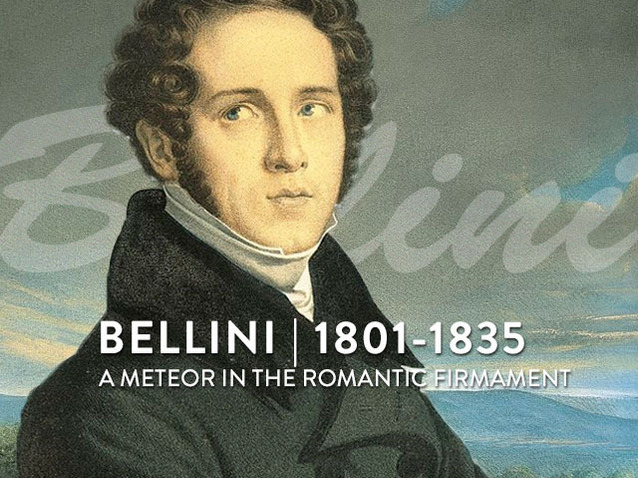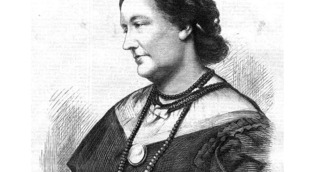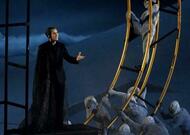 © DR
© DR
After Maria Callas, Joan Sutherland, Monserrat Caballé or recently Cecilia Bartoli, Sonya Yoncheva will be Norma for the first time, in the new production of the Royal Opera House in London, conducted by Antonio Pappano and set by Àlex Ollé (in a new setting which seems to be of a very catholic inspiration, taking place in the transalpine Gaule occupied by the Romans of the original libretto.
Yoncheva taking on the role is far from being anecdotic as the role of Norma is iconic : considered as « the role of the roles », she represents romantic bel canto at his most and is particularly feared because of the vocal demand she imposes upon thoses who dare try to sing this « voice killer » and who needs to be « sang and played with fanatism ». She is above all symptomatic of Vincenzo Bellini's work, brilliant and precocious composer, leaving ten operas and probably some of the most beautiful melodies of the repertoire before disappearing at the age of 34 under mysterious conditions. Before hearing Sonya Yoncheva's first Norma in London, we look back at Bellini's life - as romantic as his work.
***
For poet Heinrich Heine, Vincenzo Bellini was like “a sigh in court shoes”, whereas Verdi admired his “long, long, long melodies” and his supremacy in “the truth and power of declamation”. We think immediately of Bellini whenever we attach the adjective romantic to bel canto, no doubt because, beyond his operas, his destiny seems to have been dictated by the imagination of a novelist. We might come across his elegant silhouette as a young man eager to attain glory in Balzac’s Comédie Humaine. Born in Catania, in the Kingdom of Sicily, at the start of a new century, Bellini passed through the history of opera like a meteor. He shares a premature death shrouded in mystery with Mozart. Ten operas were all this brilliant and precocious composer needed to establish his own uniquely recognisable style, as evidenced by the supremely famous aria from Norma, “Casta diva”.
His exceptional melodic inventiveness produced a series of heroines torn between the torments of passion and the searing intensity of madness. Far from the reason so dear to the Classics, Bellini was also able to bring back all the poetry of brooding castles lost in the mists of the Scottish moors. Although his works to this day remain among the most popular with audiences, the musician is still largely unknown. His too-brief existence tends to be confused with that of his works, to which he devoted all his energy and sensitivity.
From Sicily to La Scala
Vincenzo Bellini’s life can be considered a fine example of social climbing as brilliant as it was fast. The glory of this man sometimes called “the Swan of Catania” is such that in 1985, to mark the 150th anniversary of his death, his portrait was chosen to appear on the Italian 5,000-lira note.

Norma's set at the ROH by la Fura del Baus
Vincenzo Bellini was born on the night of 2-3 November, 1801, in Catania, an old city in the Kingdom of the Two Sicilies. The Bellini were modest folk who led a tranquil existence centring on music. Catania’s Bellini Museum has a 12-page manuscript in which a mysterious author wrote several anecdotes intended for the great musician’s future biographers. The city’s child prodigy appears in it as a young hero displaying all the human and musical qualities one could imagine. This document’s excesses do not seem credible, and it is memorable only as an early manifestation of extreme sensitivity, which can be found in all of Bellini’s operas.
As the oldest of seven children, young Vincenzo received his first piano lessons from his father, and his early grounding in composition from his grandfather. The child showed exceptional talent early on and justified his departure for the Naples Conservatory, where he became the student of Niccolo Zingarelli (1752-1837), a composer particularly admired by Napoleon. Zingarelli taught Bellini the art of melody while taking care to shield him from the influence of the man who was then at the forefront of the opera scene, Giacomo Rossini (1792-1868), whose “opera seria” was a triumph night after night at the prestigious San Carlo theatre. Bellini held a certain admiration for Rossini while seeking right from his earliest compositions to stand apart from certain excesses of ornament and virtuosity that characterised Rossini’s. Dramatic expression and the depiction of emotions were at the core of his concerns.
In 1825, at the Naples Conservatory, Bellini presented his first opera, Adelson e Salvini, with an all-student cast. This work triumphantly crowned the end of his studies and earned him, with support from his maestro Zingarelli, an official commission from the San Carlo Theatre: Bianca e Gernando (1826) launched the young composer’s career. The libretto is by Domenico Gilardoni (1798-1831), a very popular Neapolitan librettist who would become one of the authors favoured by Gaetano Donizetti (1797-1848). One critic praised certain passages in Bianca e Gernando as “the best heard recently at the San Carlo”. Donizetti himself was enthusiastic about this new young competitor. The success was such that two years later Bellini reprised his work to fulfil a commission from the new Teatro Carlo Felice in Genoa. Bianca e Gernando became Bianca e Fernando with a libretto reworked by Felice Romani (1788-1865) and a score revised just for the occasion. This use of a pre-existing score highlights one of Bellini’s constant traits. Unlike his colleagues Rossini and Donizetti, Bellini did not compose on the spur of the moment and in response to a commission. When the management of the Genoa theatre asked him for an opera for its official opening, it gave him only three months to create it. That was far too little time for him! Bellini subsequently demanded to be paid more than anyone else so that he could devote himself entirely to his composing work according to his inspiration, without being forced to maintain some insane pace imposed by commissions from various Italian theatres. Unlike Verdi, Bellini never had to go through any exhausting “galley years”.

The success of Bianca e Gernando attracted the attention of a key figure in Italy’s opera circles, the famously truculent impresario Domenico Barbaja (1777-1841), a former café waiter who had made a fortune during the Napoleanic wars. Barbaja opened La Scala’s doors to Bellini by commissioning him to do a new work, Il Pirata (1827), which was to ensure his international fame. Fifteen triumphant performances at La Scala marked the beginning of this work’s huge success; it was reprised the year after its début in Vienna, Dresden, London, Paris and New York. A new star had appeared in the firmament of Italian opera. Bellini was acclaimed, showered with praise, saluted by his peers. He had only eight years left to live, and during that time his life became one with his works, which took over his entire being. His family and romantic attachments counted for little compared to the demands of his work. Ambitious and egotistical out of principle, he was not suited to romance. The impossible search for an eternal passion seemed to relieve him of the need to commit himself to another.
On 29 October 1827, two days after the premiere of Il Pirata, he described to his uncle the reactions of the audience: “I received so much applause that the pleasure I felt from it turned into a convulsive sobbing that I was unable to stop for a full five minutes(…). The audience, screaming like madmen, made such a din that I thought I was in hell(…) When the curtain fell, you can’t imagine the applause that called me onto the stage.”
Bellini shared the success of Il Pirata with another man.Mercadante (1795-1870) introduced the young Sicilian, fresh off the boat from Naples, to an experienced librettist, Felice Romani, who wrote all of Bellini’s future works with the exception of his last one, I Puritani (1835). Romani, nicknamed “the Dante of his time”, became the essential author of the Italian romantic melodrama. Angelo Brofferio (1802-1866), who split his life between literature and politics, paid revealing homage to the art of Felice Romani, which went so perfectly with Bellini’s: “The greater power of Romani’s genius was revealed in his representation of the delirium, ecstasy, furore, sensual pleasure and despair of love, like Byron, like Foscolo, like Lamartine, like Victor Hugo (…) So long as love beats in human hearts, Romani’s verses will live and resonate on plaintive lips as the most ardent and passionate expression of the secret tempests of the soul.”
A dazzling career
This, for Bellini, was the start of a dazzling career, of which Norma was to be the culmination. In 1829 La Straniera became even more successful than Il Pirata. Unfortunately Bellini had to wait for I Capuleti e i Montecchi (1830), inspired by Shakespeare, to erase the failure of Zaïra (1829) for which Voltaire’s tragedy had provided the subject. To win back audiences, Bellini agreed to compose a new work for La Fenice in a month-and-a-half. He took a significant portion of the score for Zaïra and adapted it to the libretto provided him by Romani – who himself reprised his Giuletta et Romeo written for Nicola Vaccai (1790-1848). The urgency with which the musician and his librettist worked explains why there are so few original elements in I Capuleti e i Montecchi. Giulietta’s irresistible“Oh quante volte”in Act 1 is a recycling of Bellini’s first opera, , Adelson e Salvini (1825). In another practice current at the time, when Maria Malibran reprised the role of Giuletta in 1832, she herself replaced the final scene conceived by Bellini with a version composed by Nicola Vaccai that seemed to her less audacious and more in keeping with the tastes of the day!
The year 1831 saw the premiere of two masterpieces that mark the apogee of Bellini’s art, La Sonnambula and Norma. La Sonnambula makes use of the theme of sleepwalking, which fascinated people in the Romantic period who were drawn to mysterious, semi-supernatural phenomena. Bellini explores all the musical solutions likely to express the complex states of mind of his heroine, the victim of some unknown illness. The work was written to order for the famous Giuditta Pasta (1797-1865), who also premiered Norma in 1831, and then of Beatrice di Tenda in 1833. In the 20th century, Maria Callas brilliantly revived this demanding bel canto repertoire. La Sonnambula was a triumph. The day after the premiere, Bellini wrote that his performers, tenor Giovanni Battista Rubini (1794-1854) and La Pasta, were “two angels who held the audience under their spell and led them to the edge of madness”. Rubini was also one of the premiere performers of Bellini’s last opera, I Puritani (1835). So the greatest singers contributed mightily to Bellini’s immense glory. Mikhaïl Glinka (1804-1857) reports in his Memoirs that everyone cried with emotion, both the singers and the audience. Proof that the passion that reigned on stage had easily won over the audience.
The art of melody
The public became imbued with these airy melodies that seem to stretch towards a heavenly infinity: Bellini transports the listener into a world of passion and dreams through his melodic writing, which seems the very quintessence of what we understand by the term “romantic bel canto”. The essentially elegiac and dreamlike melody is applied to characters marked by indecisiveness, whether it is sleepwalking, madness or a thwarted love affair. This is the case with Elvira in I Puritani, Giulietta in I Capuleti e i Montecchi and Amina in La Sonnambula.
These voices seem to be inhabited by a regular rhythm: it is the respiration of another world peopled by heroines floating between dream and reality. They need a song that touches the depths of the soul, a song that harmonises with the mysteries of Nature and with the violence of passions. Norma is the most famous example of this: the “role of roles” asserts itself as the fullest expression of majesty and suffering culminating in martyrdom. As the “perfection of tragedy”, according to Schopenhauer, Norma is both the archetype of the tragic character and the apotheosis of romantic bel canto. Blending with the tragic grandeur supported by a nobility of expression that recalls Gluck or the Mozart of Idomeneo are the bel canto skills of a romantic heroine shared between the demands of divine love, the torments of human love and the heartbreak of maternal love. Norma embodies the sensibilities of an entire era that is moving away from Reason and the Enlightenment to give itself over to the thrills of passion. “Norma” must be sung and played with fanaticism”, according to one of the role’s greatest interpreters, Lilli Lehman. That is because the title role is a true legend in the opera world, which has no shortage of legends, the greatest of whom have wanted to play it at the risk of losing their way upon contact with this “voice killer”.
The friendship between Bellini and Chopin is well known. The friendship included a musical relationship based on one element fundamental to them both: melody. With both composers, the melodic line is imbued with a melancholy that is akin to romanticism. In Chopin’s Nocturnes we find some of the seductive charm that makes Bellini’s melodies beyond compare.
The mysteries of Paris
The circumstances of Bellini’s death remain rather mysterious and novelesque. In 1828 the composer expressed a desire to win over the Parisian public like his older predecessor, Rossini. In August 1833 Bellini arrived in Paris after a stay in London. He frequented the Parisian salons where he met the musical and intellectual elite. He became friends with Rossini and especially with Chopin, who in 1831 declared: “I am happy with what I have found in this city; the finest musicians and the finest opera house in the world.”

Giulia Grisi
In January 1834, the Théâtre-Italien commissioned Bellini to compose I Puritani, which premiered on 24 January 1835. The work was a triumph, served up by exceptional performers whom history came to describe as the “the Puritan Quartet”. They were the famous Rubini (1794-1854) and the celebrated soprano Giulia Grisi (1811-1869) alongside Luigi Lablache (1794-1858) and Antonio Tamburini (1800-1876). Eight months after this memorable premiere, Bellini died suddenly on 23 September, in Puteaux, in the villa of a mysterious English friend, Solomon Levy. The composer was about to reach the age of thirty-four. The autopsy attributed his sudden death to amoebic dysentery. But rumours spread, leading to some insane theories. Levy had invested Bellini’s money in some securities that collapsed. Was he poisoned? Was it vengeance by a jealous husband ? Was the composer “held hostage” in Puteaux by his supposed benefactor who had offered him hospitality away from the hustle and bustle of Paris? Whatever the truth, the musician’s funeral at Les Invalides had huge repercussions. A long cortège accompanied him to Père-Lachaise Cemetery. Later, his remains were transferred to his native city, Catania.
A year later, in 1836, in his Stanzas for Maria Malibran who had also just died, Alfred de Musset paid homage to the composer who died too young but had already become a legend:
“Oh! how recently departed, full of life!
Under the ancient cypresses, so many new weeping willows!(…)
Bellini falls and dies! (…)
Our century’s threshold is paved with graves.”
Catherine Duault
the 09 of September, 2016 | Print



Comments